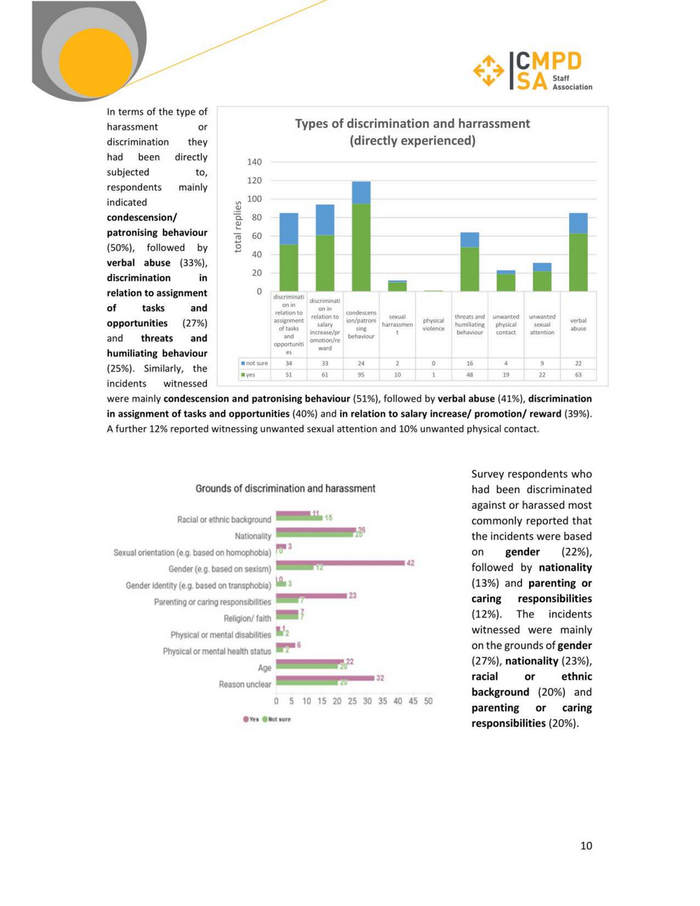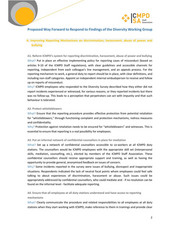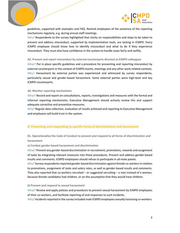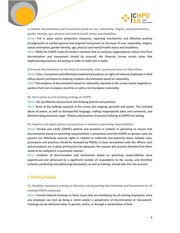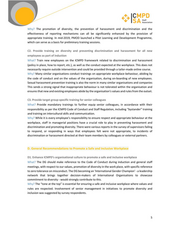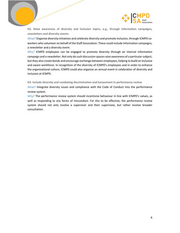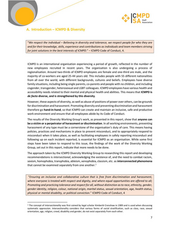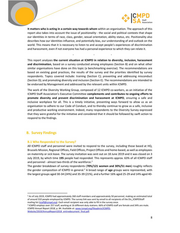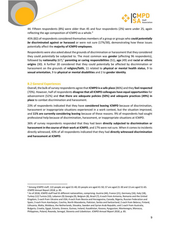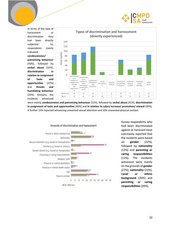ICMPD: Diversity Working Group Final Report with Recommendations
18 October 2019
4, |CMPD ISA Man Diversity Working Group Final Report with Recommendations 18 October 2019 Contents Proposed Way Forward to Respond to Findings of the Diversity Working Group .......ussususe222n00s0n0000 2 A: Introduction IEMPB:&: Diversity... RE BERTERRR Ne nbsiee 7 B; !SUrVEY.RINdingSsun.nnchnaurRER RITTER AB 8 BTWHERESHOENdET TO NE SUNVE Yen 8 BZ GEHETal ERBETIENEES „em unennnenenen ee sETe ER EReITRTeRRETETIN 9 B.3 Incidents of Discrimination and Harassment ......uuzzuusss2u0nnn00nnnnnonnannonnnnnnnannonnnnsnnnnnnnnnnnnnnnnnnnnn 11 B:4 Abuse.of. Powerand: Büllying u.a. 17 B5:TARInE ACHON ee En we Te Eee EEE TEE RER TEE 19 BE SUVEVCOTESION Senne 20 C. Training ..ueonesnenssnnenssnsnnnnnnnnsnssnennonnnnnnnnsnsnnnnnnnnnnnnsensnsnnsensnnnnnsnnsnsnnsnsnnnsnesnenssnsnssnssnnsnnsnssnsnnnnnnnenn 22 C.1 Training for All Existing Employees on Preventing and Reporting....uuussuussssnsnneununsnnnnnennennennnn 23 c.2 Training for Senior Staff on Preventing and Reporting: Bystander Training .........u.....00ss000000. 24 C:3:nduction Training Tor NEW; Stäff:;..usseonesusinnneninnnennsennnunnenenneennneeenrunnennerre en Er ever“ 24 D. Preventing and Addressing Misconduct ....ueussnsnssnnnnnennnnonnennnnnnnnnnnnnnnnnnnnonnnnnnnsennnnnnnnnnennnnennennnn 24 D.1 Prevention of Discrimination, Harassment and Bullying........uusrsssssnnssennnnsnnannnnnsunnnnnennennnnnen 25 D;2 Reporting Mechänlsn. una nRINENEREN 25 E.: 'PromötingDiversitvand Indlüsioni.scsssssserssscswesseneennecnnnennnunnnrunsee nennen nennen eT EHE HERR ee 27 EL INEFOUUELION oonnnneennen onen EmEnun LE nanL Lane LE nn a En En NH ET Eau san Enns NETTELETE NER age Ha NEE ETHERNET 27 E.2 Newsletter ....nunnsnunnnonnnnennonnnnnnnnnnnnnnnnnnnnnnnannnnnnnnnnnnnnnnunnnnnnnsnnnnnnsennnnnsnannnnsnnsnnnnnsnnsnnensnnennennnnnnn 28 E:3: Annual Diversity Event... se 28 E:4 Awareness-Ralsing Campalgn::..escasccisieeenenierenenenninennanreeenenennneenenner Teens anereereeTeTeee Teer 29 F.. ‚DNEISEUWEIBSCKEFOUNG. unuenenssene nenn nennneeeeeee 29 F.1 How it started .u.euesnennnsnensnnnenensonnnnnnnnnsnnnnnunnnnnnsannnnnnnsunnnnnssnnnnsnnsnnnnsnnasnensnsnsnsssnnannenssnssnnennnnnn 29 F:2:Main alms/activitlesa.au.uu san NEREIEHIKBRHN 30 F3:CöMpoOsHlon/ Duration un... zer TETTL EEE 30
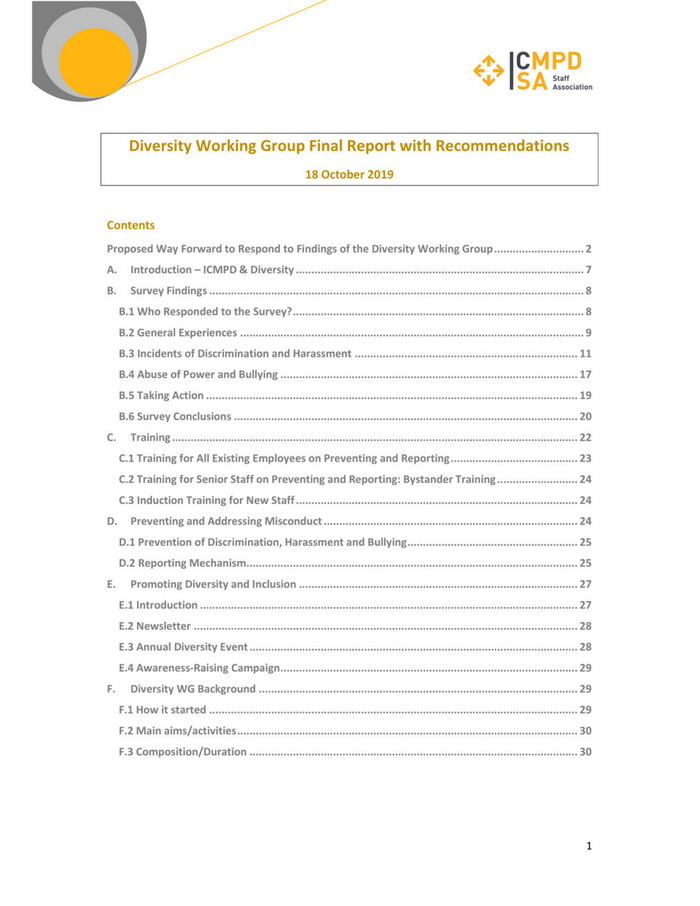
Be & |CMPD VISA Ei Proposed Way Forward to Respond to Findings of the Diversity Working Group A. Improving Reporting Mechanisms on discrimination, harassment, abuse of power and bullying A1. Reform ICMPD’s system for reporting discrimination, harassment, abuse of power and bullying What? Put in place an effective implementing policy for reporting cases of misconduct (based on articles 9-10 of the ICMPD Staff regulations), with clear guidelines and accessible channels for reporting, independent from each colleague’s line management, and an appeals process. For the reporting mechanism to work, a general duty to report should be in place, with clear definitions, and including non-staff categories. Appoint an independent internal ombudsperson to receive and follow up on reports of misconduct. Why? ICMPD employees who responded to the Diversity Survey described how they either did not report incidents experienced or witnessed, for various reasons, or they reported incidents but there was no follow-up. This leads to a perception that perpetrators can act with impunity and that such behaviour is tolerated. A2. Protect whistleblowers What? Ensure that the reporting procedure provides effective protection from potential retaliation for “whistleblowers,” through functioning complaint and protection mechanisms, redress measures and confidentiality. Why? Protection against retaliation needs to be ensured for “whistleblowers” and witnesses. This is essential to ensure that reporting is a real possibility for employees. A3. Put an informal network of confidential counsellors in place for mediation What? Set up a network of confidential counsellors accessible to co-workers at all ICMPD duty stations. The counsellors would be ICMPD employees with the appropriate skill set (interpersonal skills, mediation, counselling, etc.), elected by members of the ICMPD Staff Association. These confidential counsellors should receive appropriate support and training, as well as having the opportunity to provide general, anonymised feedback on issues of concern. Why? Some incidents reported in the survey were issues of bullying, disrespect and inappropriate situations. Respondents indicated the lack of neutral focal points whom employees could feel safe talking to about experiences of discrimination, harassment or abuse. Such issues could be appropriately addressed by confidential counsellors, who could mediate and - if no resolution can be found on the informal level - facilitate adequate reporting. A4. Ensure that all employees at all duty stations understand and have access to reporting mechanisms What? Clearly communicate the procedure and related responsibilities to all employees at all duty stations when they start working with ICMPD, make reference to them in trainings and provide clear
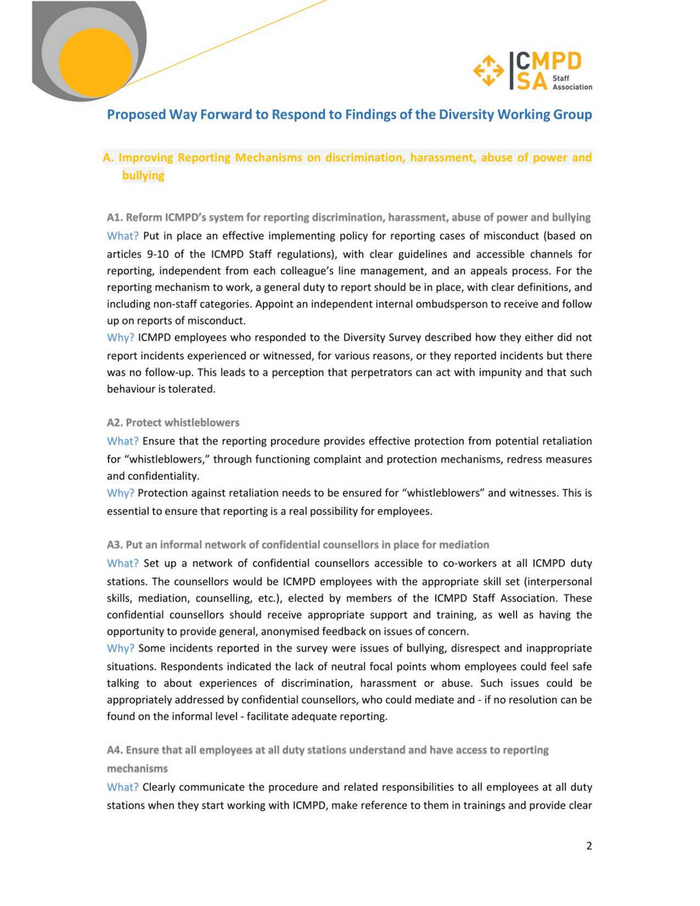
Be > |EMPD VISA ae guidelines, supported with examples and FAQ. Remind employees of the existence of the reporting mechanisms regularly, e.g. during annual staff meetings. \Why? Respondents to the survey highlighted that clarity on responsibilities and steps to be taken to prevent and address misconduct, supported by implementation tools, are lacking in ICMPD. Every ICMPD employee should know how to identify misconduct and what to do if they experience misconduct. They must also have confidence in the system to handle cases fairly and swiftly. AS. Prevent and report misconduct by external counterparts directed at ICMPD colleagues What? Put in place specific guidelines and a procedure for preventing and reporting misconduct by external counterparts in the context of ICMPD events, meetings and any other work-related contexts. Why? Harassment by external parties was experienced and witnessed by survey respondents, particularly sexual and gender-based harassment. Some external parties were high-level and key ICMPD counterparts. A6. Monitor reporting mechanisms What? Record and report on consultations, reports, investigations and measures with the formal and informal reporting mechanisms. Executive Management should actively review this and support adequate corrective and preventive measures. Why? Regular data collection, evaluation of results achieved and reporting to Executive Management and employees will build trust in the system. B. Preventing and responding to specific forms of discrimination and harassment B1. Operationalise the Code of Conduct to prevent and respond to all forms of discrimination and harassment a) Combat gender-based harassment and discrimination \What? Prevent any gender-based discrimination in recruitment, promotions, rewards and assignment of tasks by integrating relevant measures into these procedures. Prevent and address gender-based insults and comments. ICMPD employees should refuse to participate in all-male panels. Why? Survey respondents reported gender-based discrimination against female co-workers in relation to promotions, assignment of tasks and salary rates, as well as gender-based insults and comments. They also reported that co-workers recruited — or suggested recruiting - a man instead of a woman, because female candidates had children, or on the assumption that they would have children. b) Prevent and respond to sexual harassment What? Review and apply policies and procedures to prevent sexual harassment by ICMPD employees of their co-workers, and facilitate reporting of and responses to such incidents. Why? Incidents reported in the survey included male ICMPD employees sexually harassing co-workers.
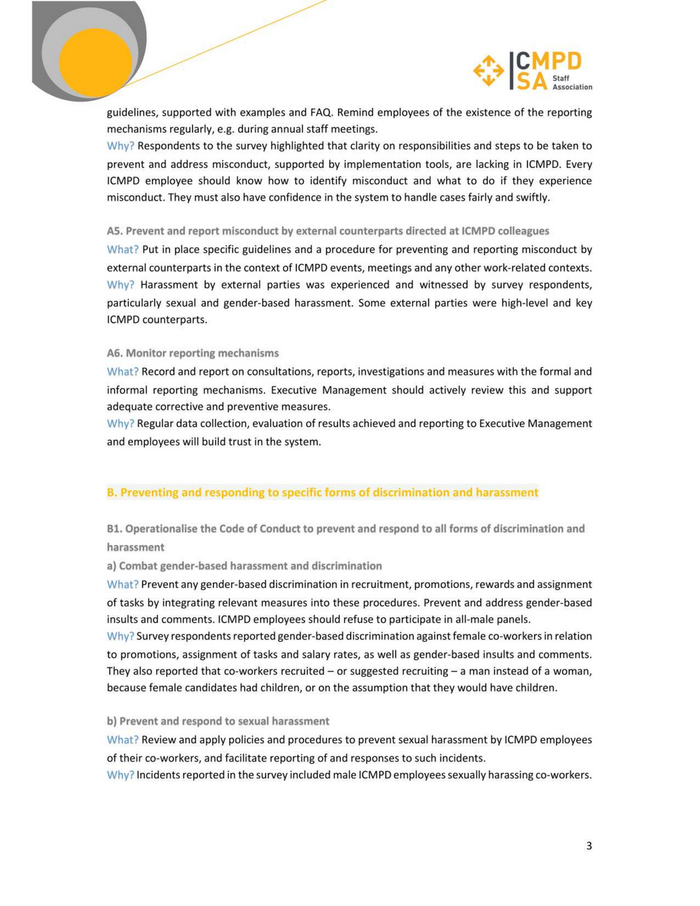
Be > |EMPD VISA Kesen c) Combat discrimination and harassment based on race, nationality, religion, sexual orientation, gender identity, age, physical and mental health status and disabilities What? Put in place active prevention measures, reporting mechanisms and effective punitive arrangements to combat general and targeted harassment on the basis of race, nationality, religion, sexual orientation, gender identity, age, physical and mental health status and disabilities. Why? While the ICMPD Code of Conduct mentions that an inclusive organisational culture free from discrimination and harassment should be ensured, the Diversity Survey results show that implementing practices are lacking in order to make this a reality. d) Prevent discrimination on the basis of nationality, with a particular focus on field offices What? Clear, transparent and effectively implemented policies on rights of national employees in field offices would contribute to resolving incidents discrimination based on nationality. \Why? The incidents of discrimination based on nationality reported in the survey mainly targeted co- workers from non-European countries or with a non-European nationality. B2. Put in place an anti-bullying strategy at ICMPD What? Set up effective and practical anti-bullying policies and practices. \Why? Some of the bullying reported in the survey was ongoing, personal and severe. This included abuse of power, as well as disrespectful language, making inappropriate jokes and comments, and demonstrating excessive anger. Policies and practices to prevent bullying at ICMPD are lacking. B3. Improve and apply policies and practices in relation to parenting responsibilities What? Review and clarify ICMPD’s policies and practices in relation to parenting to ensure that discrimination based on parenting responsibilities is prevented, and that ICMPD co-workers who are parents can effectively exercise rights in relation to maternity and paternity leave. Related rules, procedures and practices should be reviewed by PMOD, in close consultation with ISA. Where rules and procedures are in place and found to be adequate, the reasons why practice deviates from them needs to be analysed in a systematic manner. Why? Incidents of discrimination and harassment based on parenting responsibilities were experienced and witnessed by a significant number of respondents to the survey, and therefore activities preventing and addressing misconduct, as well as training, should take this into account. C. Providing Training C1. Establish mandatory training on diversity and preventing discrimination and harassment for all existing ICMPD employees What? Provide tailored trainings on these issues that are mandatory for all existing employees, since any employee can end up being a victim and/or a perpetrator of discrimination or harassment. Trainings can be delivered either in-person, online, or through a combination of both.
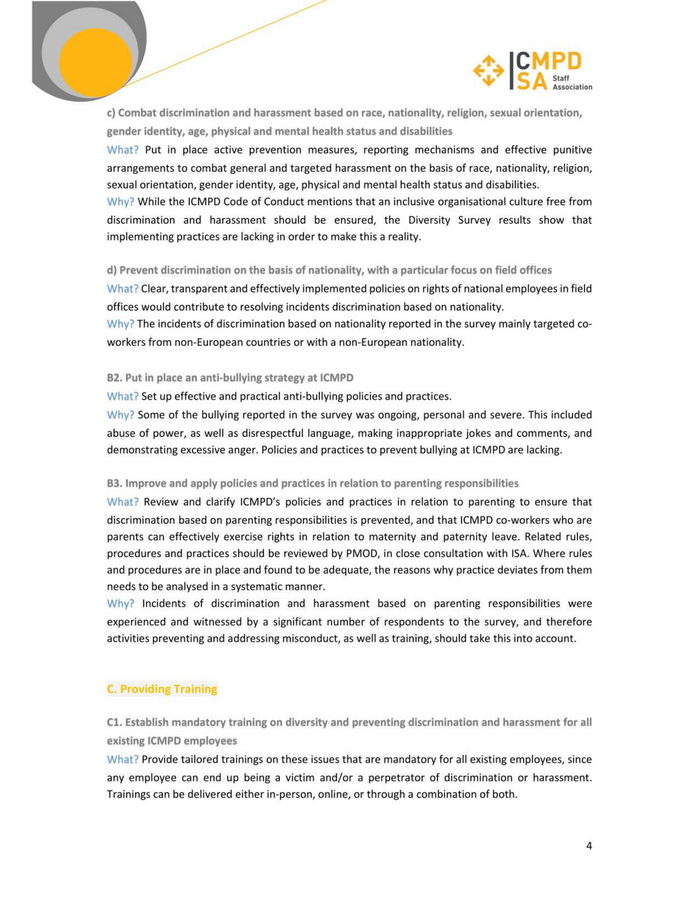
Be > |EMPD VISA Hasen Why? The promotion of diversity, the prevention of harassment and discrimination and the effectiveness of reporting mechanisms can all be significantly enhanced by the provision of appropriate training. In mid-2019, PMOD launched a Pilot Learning and Development Programme, which can serve as a basis for preliminary training sessions. C2. Provide training on diversity and preventing discrimination and harassment for all new employees as part of induction What? Train new employees on the ICMPD framework related to discrimination and harassment (policy in place, how to report, etc.), as well as the conduct expected at the workplace. This does not necessarily require outside intervention and could be provided through a tailor-made online course. Why? Many similar organisations conduct trainings on appropriate workplace behaviour, abiding by the code of conduct and on the values of the organisation, during on-boarding of new employees. Sexual harassment prevention training is also the norm in many similar organisations and companies This sends a strong signal that inappropriate behaviour is not tolerated within the organisation and ensures that new and existing employees abide by the organisation’s values and rules from the outset. C3. Provide target group-specific training for senior colleagues What? Provide mandatory trainings to further equip senior colleagues, in accordance with their responsibility as per the ICMPD Code of Conduct and Staff Regulation, including “bystander” training and training on intercultural skills and communication. Why? While it is every employee’s responsibility to ensure respect and appropriate behaviour at the workplace, staff in managerial positions have a crucial role to play in preventing harassment and discrimination and promoting diversity. There were various reports in the survey of supervisors failing to respond, or responding in ways that employees felt were not appropriate, to incidents of discrimination or harassment directed at their team members by colleagues or external partners. D. General Recommendations to Promote a Safe and Inclusive Workplace D1. Enhance ICMPD’s organisational culture to promote a safe and inclusive workplace What? The DG should make reference to the Code of Conduct during induction and general staff meetings, with respect to our values, promotion of diversity in the work place, with specific reference to zero tolerance on misconduct. The DG becoming an ‘International Gender Champion’ - a leadership network that brings together decision-makers of International Organisations to showcase commitment to diversity - would strongly contribute to this. \Why? The “tone at the top” is essential for ensuring a safe and inclusive workplace where values and rules are respected. Involvement of senior management in initiatives to promote diversity and inclusion was suggested by survey respondents.
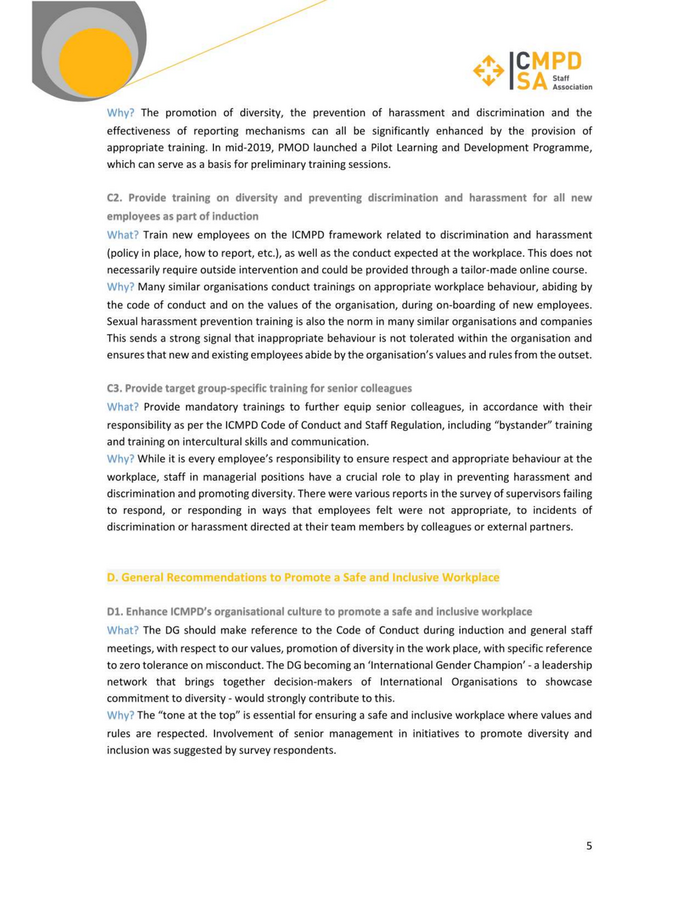
4, |CMP v | e . D2. Raise awareness of diversity and inclusion topics, e.g., through information campaigns, newsletters and diversity events What? Organise diversity initiatives and celebrate diversity and promote inclusion, through ICMPD co- workers who volunteer on behalf ofthe Staff Association. These could include information campaigns, a newsletter and a diversity event. Why? ICMPD employees can be engaged to promote diversity through an internal information campaign and a newsletter. Not only do such discussion spaces raise awareness of a particular subject, but they also create bonds and encourage exchange between employees, helping to build an inclusive and aware workforce. In recognition of the diversity of ICMPD’s employees and in order to enhance the organisational culture, ICMPD could also organise an annual event in celebration of diversity and inclusion at ICMPD. D3, Include diversity and combating discrimination and harassment in performance review What? Integrate diversity issues and compliance with the Code of Conduct into the performance review system. Why? The performance review system should incentivise behaviour in line with ICMPD’s values, as well as responding to any forms of misconduct. For this to be effective, the performance review system should not only involve a supervisor and their supervisee, but rather involve broader consultation.
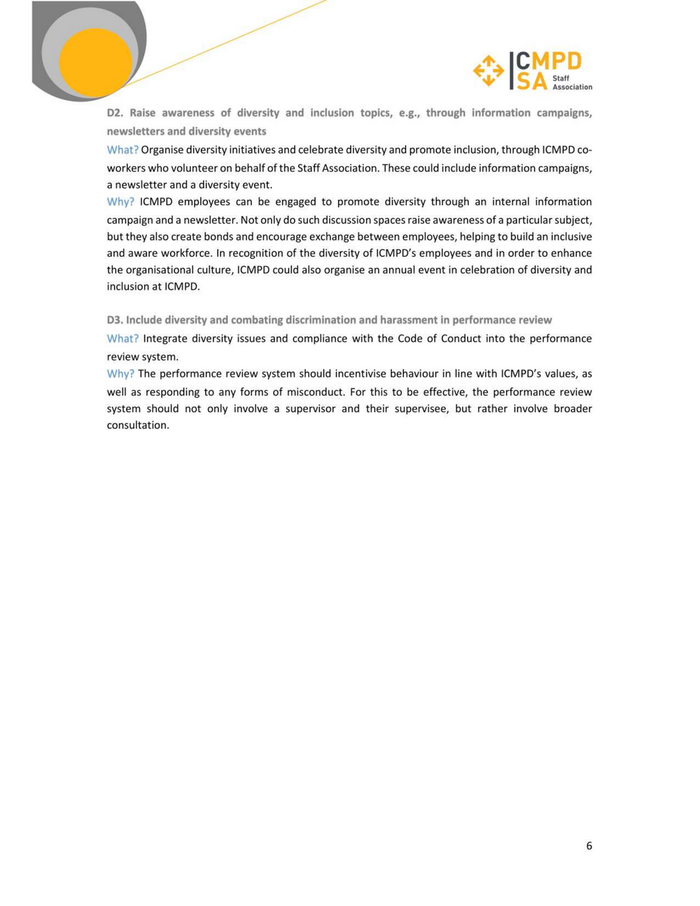
ui v 5 A An astiot A. Introduction - ICMPD & Diversity “We respect the individual — Believing in diversity and tolerance, we respect people for who they are and for their knowledge, skills, experience and contributions as individuals and team members striving for joint solutions in the best interests of ICMPD.” — ICMPD Code of Conduct, 4. ICMPD is an international organisation experiencing a period of growth, reflected in the number of new employees recruited in recent years. The organisation is also undergoing a process of regionalisation. Around two-thirds of ICMPD employees are female and one-third are male, and the majority of co-workers are aged 25-44 years old. This includes people with 55 different nationalities from all over the world, with different backgrounds, cultures and beliefs. Employees have diverse family situations, including being single parents, co-parents and people with no children, and including cisgender, transgender, heterosexual and LGBT colleagues. ICMPD employees have various health and accessibility needs related to their mental and physical health and abilities. This means that ICMPD is de facto diverse, and is strengthened by this diversity. However, these aspects of diversity, as well as abuse of positions of power over others, can be grounds for discrimination and harassment. Promoting diversity and preventing discrimination and harassment therefore go hand-in-hand, so that ICMPD can create and maintain an inclusive, safe and productive work environment and ensure that all employees abide by its Code of Conduct. The results of the Diversity Working Group’s work, as presented in this report, show that anyone can be a victim or a perpetrator of harassment or discrimination. In all working environments, preventing harassment of any type must be a cornerstone of the organisation’s duty of care. This means having policies, practices and mechanisms in place to prevent misconduct, and to appropriately respond to misconduct when it takes place, as well as facilitating employees in safely reporting misconduct and following up on each incident reported, is essential for ICMPD as an organisation. While some first steps have been taken to respond to this issue, the findings of the work of the Diversity Working Group, set out in this report, indicate that more needs to be done. The approach taken by the ICMPD Diversity Working Group to researching this report and developing recommendations is intersectional, acknowledging the existence of, and the need to combat racism, sexism, homophobia, transphobia, ableism, xenophobia, classism, etc. as interconnected phenomena that cannot be examined separately from one another.' “Ensuring an inclusive and collaborative culture that is free from discrimination and harassment, where everyone is treated with respect and dignity, and where equal opportunities are offered to all; Promoting and practicing tolerance and respect for all, without distinction as to race, ethnicity, gender, gender identity, religion, colour, national origin, marital status, sexual orientation, age, health status, physical or mental disability, or political conviction.” ICMPD Code of Conduct, 4 1 The concept of Intersectionality was first coined by legal scholar Kimberl& Crenshaw in 1989 and is used when discussing systematic oppression. Intersectionality considers that various forms of social stratification, such as class, race, sexual orientation, age, religion, creed, disability and gender, do not exist separately from each other.
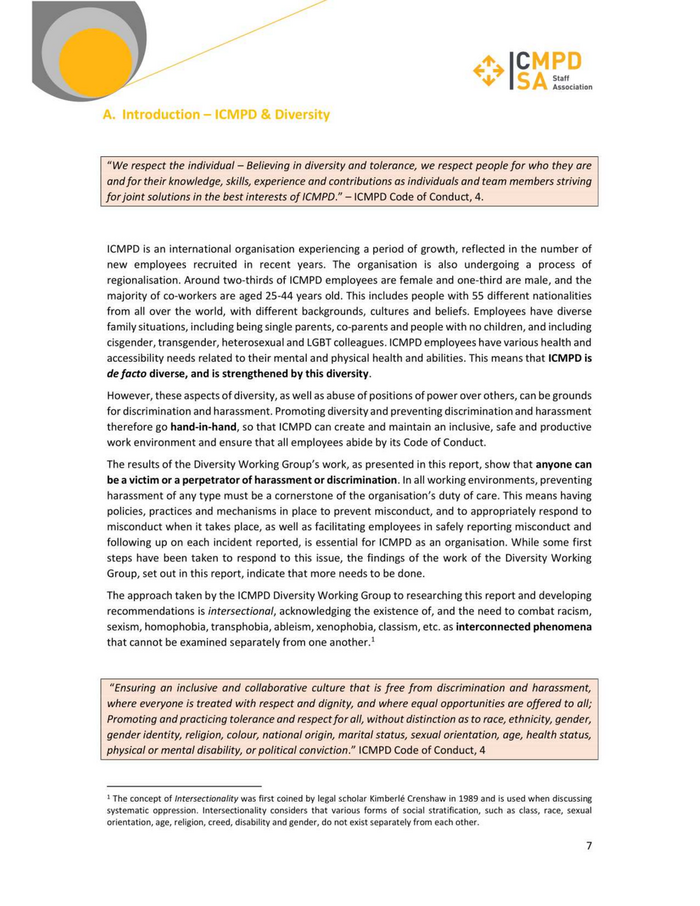
ui pr +, ICMPD Be ISA... It matters who is acting in a certain way towards whom within an organisation. The approach of this report also takes into account the issue of positionality - the social and political contexts that shape our identities in terms of race, class, gender, sexual orientation, ability status, etc. Positionality also describes how our identities influence, and potentially bias, our understanding of and outlook on the world. This means that it is necessary to listen to and accept people’s experiences of discrimination and harassment, even if not everyone has had a personal experience to which they can relate it. This report analyses the current situation at ICMPD in relation to diversity, inclusion, harassment and discrimination, based on a survey conducted among employees (Section B) and on what other similar organisations have done on this topic (a benchmarking exercise). The recommendations are based on existing good practices, the results of the survey and the priorities identified by survey respondents. Topics covered include: training (Section C); preventing and addressing misconduct (Section D); and promoting diversity and inclusion (Section E). The recommendations are intended to be endorsed by Management and addressed by the relevant units within ICMPD. The work of the Diversity Working Group, composed of 12 ICMPD co-workers, as an initiative of the ICMPD Staff Association’s Executive Committee complements and contributes to ongoing efforts to promote diversity and prevent discrimination and harassment at ICMPD, ensuring a safe and inclusive workplace for all. This is a timely initiative, presenting ways forward to allow us as an organisation to adhere to our Code of Conduct, and to thereby continue to grow as a safe, inclusive and productive working environment. Indeed, many respondents to the Diversity Survey expressed that they were grateful for the initiative and considered that it should be followed by swift action to respond to the findings. B. Survey Findings B.1 Who Responded to the Survey? All ICMPD staff and personnel were invited to respond to the survey, including those based at HQ, Brussels Mission, Regional Offices, Field Offices, Project Offices and home-based, as well as employees on maternity or sick leave. The survey invitation was sent out on 18 June 2019 and it was closed on 3 July 2019, by which time 195 people had responded. This represents approx. 63% of all ICMPD staff and personnel - almost two-thirds of the workforce.? The gender breakdown of survey respondents (70%/121 women and 30%/51 men) roughly reflects the gender composition of ICMPD in general.” A broad range of age groups were represented, with the largest groups aged 30-34 (24%) and 35-39 (21%), and a further 16% aged 25-29 and 14% aged 40- 2 As of July 2019, ICMPD had approximately 260 staff members and approximately 50 personnel, making an estimated total of around 310 people employed by ICMPD. The survey link was sent by email to all recipients of the Dis_ICMPDStaff mailing list (staff@icmpd.org). Each email recipient was only able to fill inthe survey once. 3 ICMPD employs over 257 staff, working at 16 different duty stations. 66% of ICMPD staff are female and 34% are male. ICMPD Annual Report 2018, p. 84. Available at: www.icmpd.org/fileadmin/ICMPD- Website/2019/AnnualReport2018 entiredocument final.pdf.
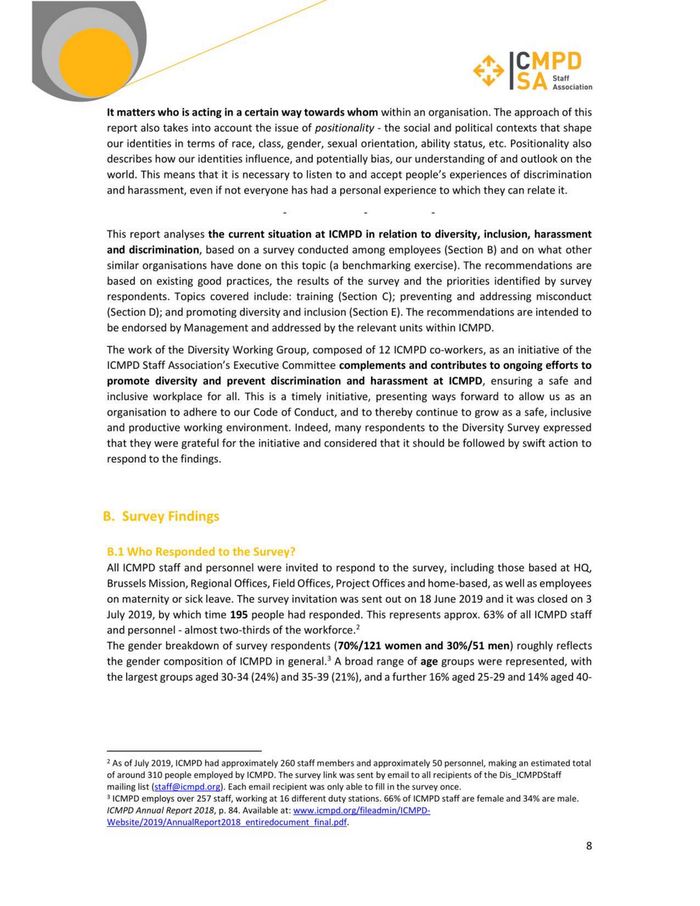
ui v 5 A An astiot 44. Fifteen respondents (8%) were older than 45 and four respondents (2%) were under 25, again reflecting the age composition of ICMPD as a whole.” 45% (82) of respondents considered themselves members of a group or groups who could potentially be discriminated against or harassed or were not sure (17%/30), demonstrating how these issues potentially affect the majority of ICMPD employees. Respondents were also asked about the grounds of discrimination or harassment that they considered they could potentially be subjected to. The most common was gender (affecting 96 respondents), followed by nationality (67),° parenting or caring responsibilities (51), age (49) and racial or ethnic origins (30). A further 20 considered that they could potentially be affected by discrimination or harassment on the grounds of religion/faith, 11 related to physical or mental health status, 9 to sexual orientation, 9 to physical or mental disabilities and 2 to gender identity. B.2 General Experiences Overall, the bulk of survey respondents agree that ICMPD is a safe place (86%) and they feelrespected (70%). However, half of respondents disagree that all ICMPD colleagues have equal opportunities for advancement (52%) and that there are adequate policies (50%) and adequate practices (49%) in place to combat discrimination and harassment. 23% of respondents indicated that they have considered leaving ICMPD because of discrimination, harassment or inappropriate situations experienced in a work context, but the situation Improved, and 11% are currently considering leaving because of these reasons. 9% of respondents had sought professional help because of discrimination, harassment, or inappropriate situations at ICMPD. 36% of survey respondents responded that they had been directly subjected to discrimination or harassment in the course of their work at ICMPD, and 17% were not sure. When it comes to incidents directly witnessed, 43% of all respondents indicated that they had directly witnessed discrimination and harassment at ICMPD. “ Among ICMPD staff, 122 people are aged 31-40; 65 people are aged 41-50; 57 are aged 21-30 and 13 are aged 51-65. ICMPD Annual Report 2018, p. 85. 5 As of 2018, ICMPD staff had 55 different nationalities, comprising: Austria (44), France (21), Germany (16), Italy (18), Turkey (12) Tunisia (10), Lebanon (9) Georgia (9), Belgium (8), Brazil (7); 6 each from Armenia, Romania and the United Kingdom; 5 each from Ukraine and USA; 4 each from Bosnia and Herzegovina, Canada, Nigeria, Russian Federation and Spain; 3 each from Azerbaijan, Czechia, North Macedonia, Pakistan, Serbia and Switzerland; 2 each from Belarus, Finland, Lithuania, Malta, Moldova, the Netherlands, Slovakia, Sweden and Syrian Arab Republic; and 1 each from Australia, Bulgaria, Croatia, Egypt, Estonia, Greece, Guinea, Ireland, Kazakhstan, Kosovo, Kyrgyzstan, Montenegro, Morocco, Philippines, Poland, Rwanda, Senegal, Slovenia and Uzbekistan. ICMPD Annual Report 2018, p. 85.
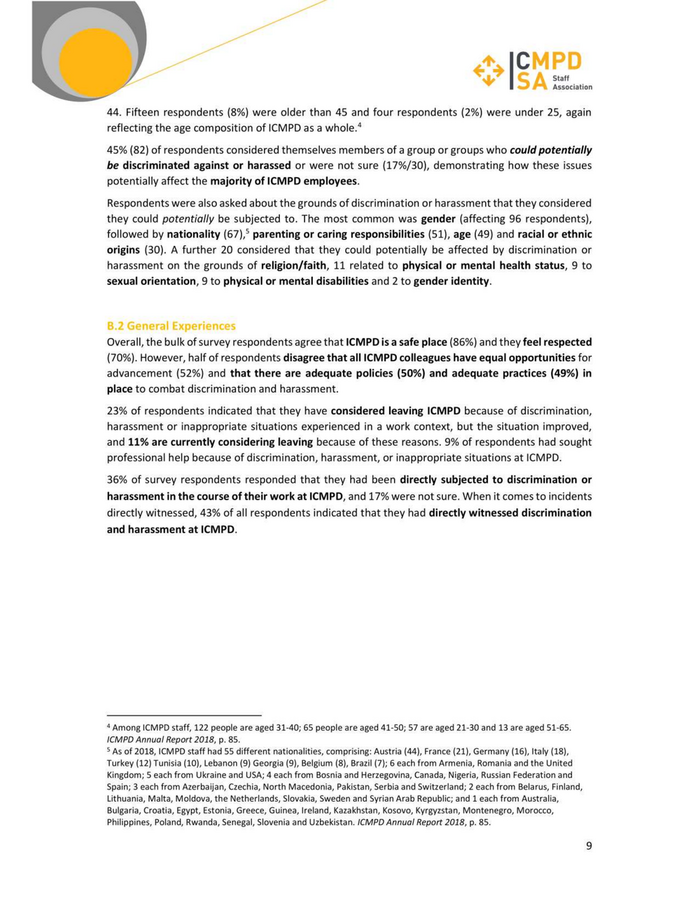
*, ICMPD ISA Ma In terms of the type of hafässirient ö Types of discrimination and harrassment discrimination they (directly experienced) had been directly 140 subjected to, 4 120 respondents mainly indicated 2 100 condescension/ Ss 80 patronising behaviour z 60 (50%), followed by 8 10 verbal abuse (33%), discrimination in =D Pan N nl relation to assignment e a L iscriminati of tasks and Ye in relation Mn Pe to CFESCENE sexual hysical threatsand unwanted | unwanted bal opportunities (27%) rn salary ion/patroni |} urrassmen | PNyslca humillating | physical sexual Br “ PEIDS Increase/pr sing voeneR behaviour contact attention apuse and threats and Bi; nie; Omotion/re | behavlour humiliating behaviour es vw. "not sure 34 33 24 2 0 16 4 9 22 (25%). Similarly, the incidents witnessed were mainly condescension and patronising behaviour (51%), followed by verbal abuse (41%), discrimination in assignment of tasks and opportunities (40%) and in relation to salary increase/ promotion/ reward (39%). A further 12% reported witnessing unwanted sexual attention and 10% unwanted physical contact. wyes 51 61 95 10 1 48 19 22 63 Survey respondents who Grounds of discrimination and harassment had been discriminated against or harassed most Racial or ethnic background | commonly reported that Natlonality —— the incidents were based Sexual orientation (e.9. based on homophobia) MP" » on gender (22%), Gender (e.g. based on sexism) U — followed by nationality Gender identity (e.g. based on transphobia) kl 3 (13%) and parenting or Parenting or caring responsibilities 23 caring responsibilities Religion/ rarıh MAN ? (12%). The incidents Physical or mental disabilities Mb'2 witnessed were mainly Physical or mental health status mr on the grounds of gender ne EMEEEEEEP?:2 (27%), nationality (23%), Reason unciosr En 32 racial or ethnic background (20%) and parenting or caring TEEN responsibilities (20%). 0 5 10 15 20 25 30 35 40 45 50 10
